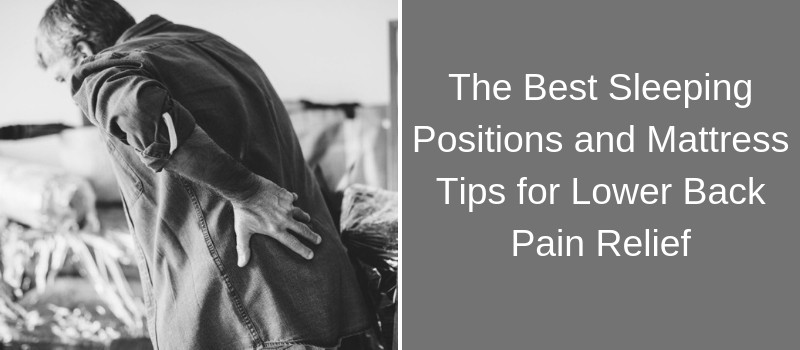Do you suffer with or experience lower back pain? If so, well, you are not alone. According to the Global Burden of Disease study, lower back pain is the main cause of disability all over the world.

And do you know what is more engrossing is that most lower back pain isn’t promoted by grave medical problems, such as arthritis or cancer?
Rather, it is usually caused by strain or stress from awkward sleeping positions, bad posture, and other habits.
Also, sleeping on an ill-fitting mattress can cause lower back pain. Not enough support from a mattress promotes muscle strains, poor sleep posture, and doesn’t aid in aligning your spine, all of which are factors in causing lower back pain.
Moreover, sleep comfort is sacrificed if a bed doesn’t match the individual preferences of a person. For a little help, here are the ideal sleeping positions and practical guidelines in choosing a mattress if you have lower back pain. Read on!
Best Sleeping Positions
If you have lower back pain, here are the ideal sleeping positions to try.
In a Reclined Position, Sleep on Your Back
Are you comfortable and relaxed, sleeping in a recliner? Even if sleeping or snoozing in a chair might not be the ideal option for back pain, this sleeping position can be helpful if you experience isthmic spondylolisthesis.
Get an adjustable bed so that you can sleep in a reclined position comfortably, with the best support and alignment, this sleeping position aids in reducing the strain on your spine by creating an angle between your trunk and thighs.
With a Pillow Under Your Knees, Sleep on Your Back
For some sleepers, resting on one’s back might be the best sleeping position to alleviate back pain. All you need to do is to lay flat on your back, put a pillow under your knees, and keep your spine unaligned.
The pillow is crucial because it keeps the curve in your back. Also, you can put a rolled up, small towel underneath the small of your back for extra support.
When sleeping on your back, your weight is proportionally spread and distributed across the big areas of your body. In turn, you put less pressure and strain on your joints. Also, you get to have a much better spine alignment.
With a Pillow Under Your Abdomen, Sleep on Your Stomach
For sure, you’ve heard that sleeping on your stomach is not good for back pain. Well, it’s quite true as it may bring additional stress to your neck.
However, if you prefer sleeping on your stomach, you do not have to coerce yourself to rest in another position. Rather, put a pillow underneath your lower abdomen and pelvis to alleviate some of the strain off your back.
Also, based on how this posture feels, you might or might not select to use a pillow underneath your head — this position help in relieving stress that’s placed on the gap between your discs.
Fetal Position
You might want to sleep on your side in a fetal position if you have a herniated disc. To do this, rest on your back and then gently roll over or curl onto your side.
Push your knees in the direction of your chest and slowly roll your torso to your knees. Keep in mind to change sides every now and then to avoid any imbalances.
With a Pillow On Your Knees, Sleep on Your Side
If sleeping on your back is uncomfortable for you, consider switching over to your side. To do this, let your left or right shoulder to feel the mattress, as well as that side of your body.
Situate a pillow in the middle of your knees. When there is a space between the mattress and your waist, try using a smaller pillow for more support.
Mattress Tips
The following tips are made to aid sleepers with lower back pain to select the best mattress for both sleep comfort and back support.
Back Support
The best mattress for lower back pain must give support for the natural alignment and curves of the spine. The correct amount of back support aids sleepers in avoiding muscle numbness in the morning.
Although there are hardly any medical data about mattresses, medium-firm mattresses, according to one study, typically offer more back pain alleviation compared to firm mattresses.
Learn the Physical Attributes of the Mattress
The inner springs or coils of a mattress give or supply the support. Various mattresses differ in their arrangement and number of coils.
The mattresses’ padding on top arrives in various thicknesses. Also, mattress depths usually range between seven to eighteen inches deep. You must base your decision on your preferences when selecting the type of padding, the number of coils, and mattress depths.
Personal Preference
There’s no single type or style of mattress that goes well for all sleepers with lower back pain. Any bed that aids people to sleep comfortably without stiffness and pain is the best option for that person. People need to pick out a mattress that meets their needs for support and comfort, allowing them to get a great night’s sleep.
Takeaway
Alignment is key for people suffering from lower back pain. So, whatever sleeping position you opt to and mattress you choose, keeping the correct spine alignment is the most critical part of the equation. Also, when buying a new mattress, test different mattresses to determine the best fit.
Author’s Bio:
 Analisse Weathers is a blogger and writer. She mainly writes about home improvement, home renovation, home repairs, and just about anything related to home-related subjects. Analisse loves to write these topics as she aspires to become an interior designer someday. In her spare time, she spends time with her family and friends.
Analisse Weathers is a blogger and writer. She mainly writes about home improvement, home renovation, home repairs, and just about anything related to home-related subjects. Analisse loves to write these topics as she aspires to become an interior designer someday. In her spare time, she spends time with her family and friends.
Related Posts
- Comparison of Duvet vs Quilt vs Blanket: Cozy Bedding Explained
- Pros and Cons of Electric Blankets and Safety Guide
- Comparison of Murphy Bed vs Sleeper Sofa For Your Home
- Different Types of Doors for Closets – Design Ideas with Pictures
- Two Color Combination for Bedroom Walls – Design Ideas
- White and Gold Bedroom Design Ideas With Unique Photos
Leave a Reply